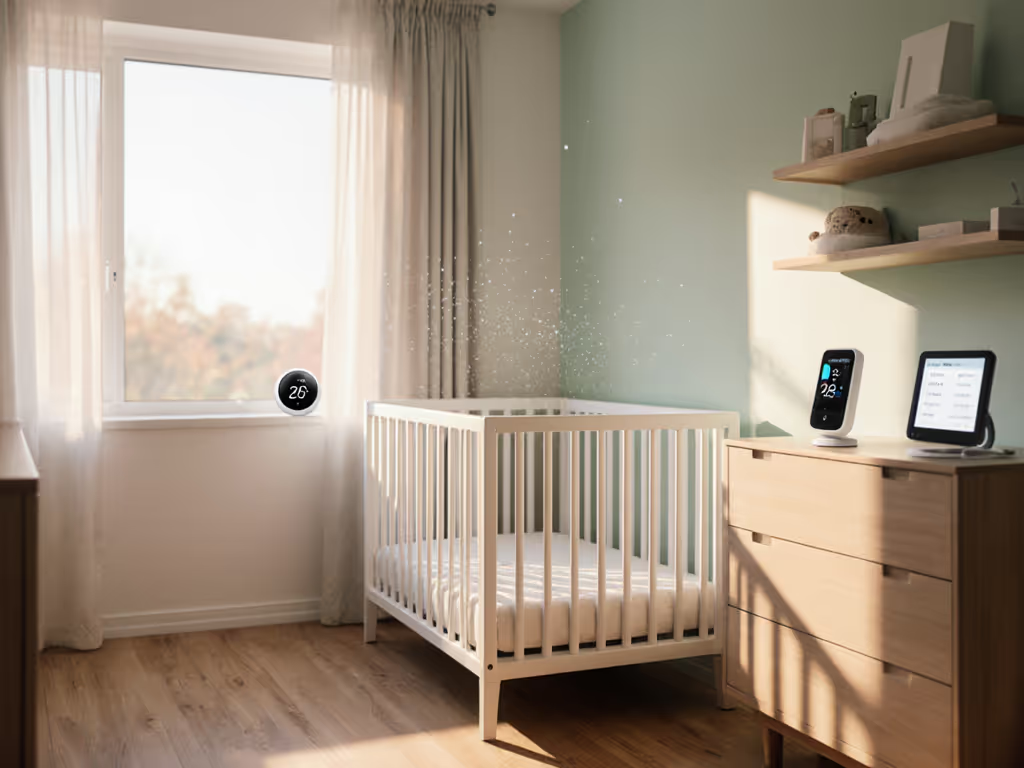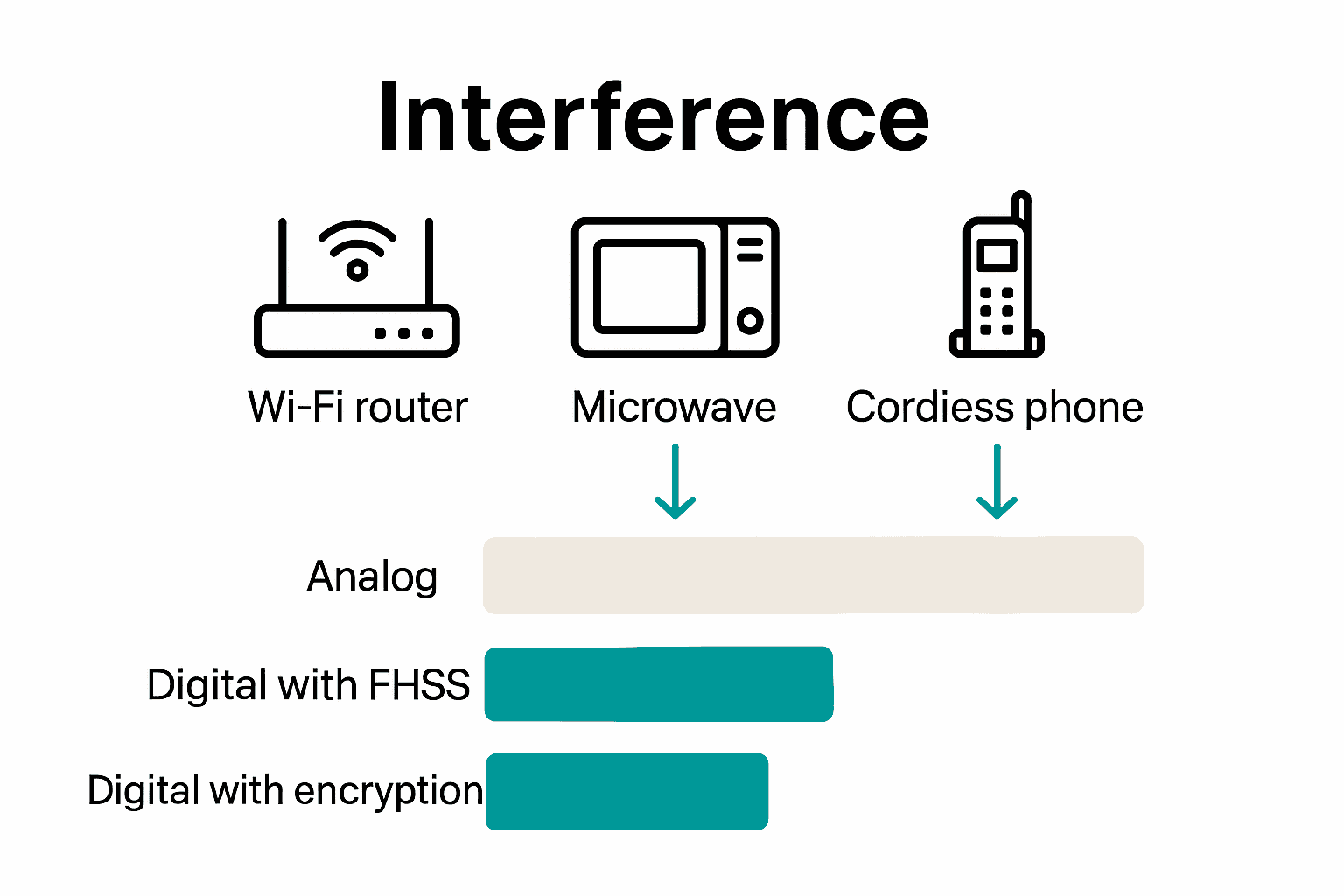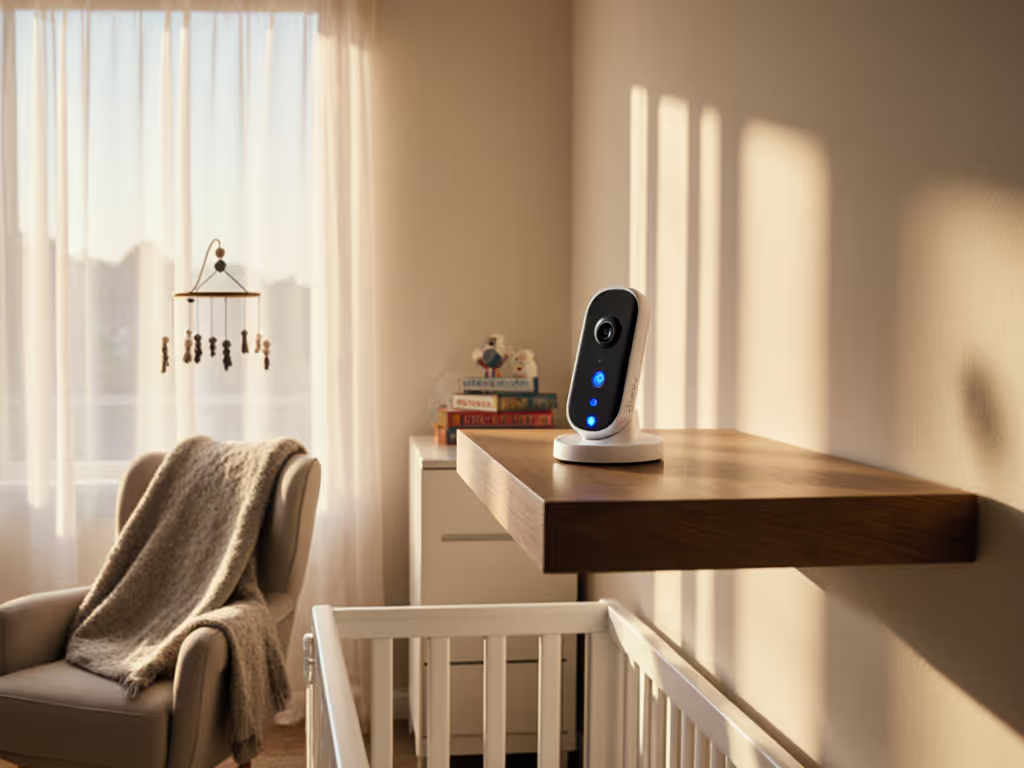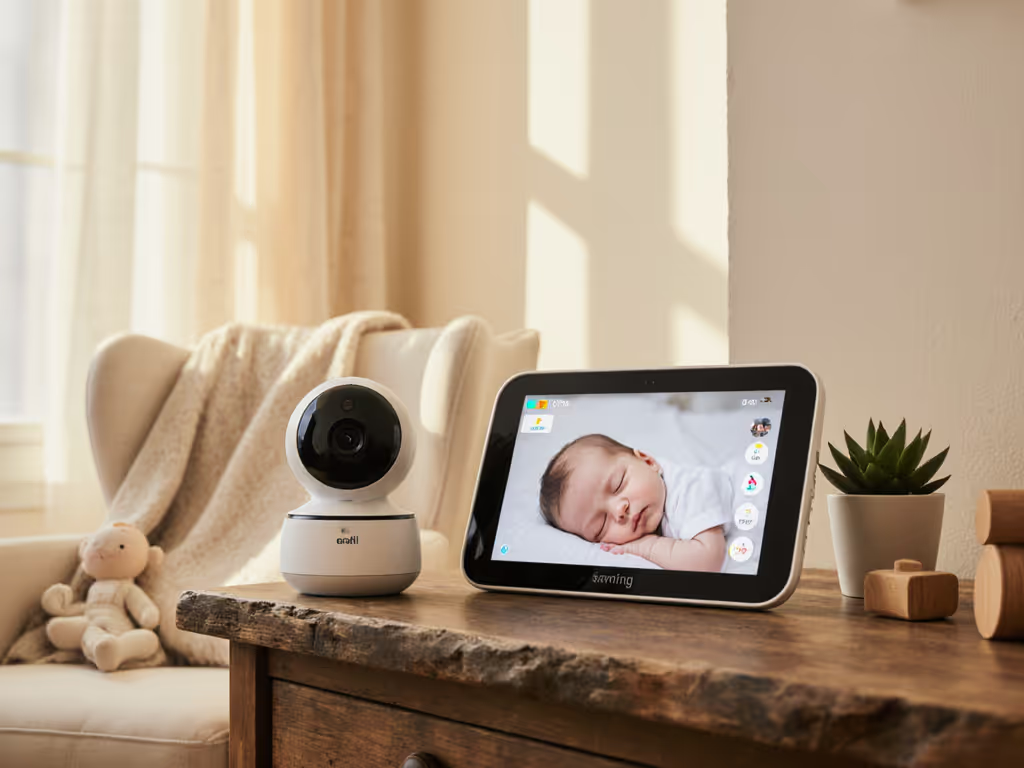
Baby Monitor Interference: Complete Guide for Parents

Over 80 percent of baby monitors share their frequencies with common household devices, leading to signals that sometimes cross or clash. For parents, this unexpected interference can turn a simple baby monitor into a source of confusion and worry. Knowing what causes these disruptions not only protects your peace of mind but also helps you make better choices about your child’s safety and the reliability of your monitoring system.
Key Takeaways
| Point | Details |
|---|---|
| Understanding Interference | Baby monitor interference arises from competing electronic devices on similar frequencies, causing audio and video disruptions. |
| Minimizing Signal Disruption | Position baby monitors away from interference sources and consider using frequency-hopping technology for better performance. |
| Monitoring Performance | Regularly assess your baby monitor’s signal quality and adjust its placement or channel to ensure reliable operation. |
| Prioritizing Security | Choose monitors with strong digital encryption and maintain firmware updates to protect against potential security vulnerabilities. |
What Is Baby Monitor Interference?
Baby monitor interference represents a complex electronic phenomenon where radio signals get disrupted or distorted, potentially compromising the device's ability to transmit clear audio and video signals from your baby's room.
At its core, interference occurs when multiple electronic devices operate on similar radio frequencies, creating signal crossovers and noise. These disruptions can stem from a variety of household electronics, including wireless routers, cordless phones, microwave ovens, and even neighboring baby monitors. The result? Static, audio dropouts, or intermittent video quality that can leave parents feeling anxious and uncertain about their monitoring setup.
Types of Interference Sources
Interference can be classified into several critical categories:
- Electromagnetic Interference (EMI): Generated by electrical devices like refrigerators, televisions, and computer equipment
- Radio Frequency Interference (RFI): Caused by wireless devices operating on similar bandwidths
- Physical Obstructions: Walls, metal objects, and dense building materials that block or weaken wireless signals
- Signal Overlap: Multiple devices competing for the same frequency channels
Understanding these interference sources helps parents make informed decisions about their baby monitoring technology. Modern monitors increasingly use advanced frequency-hopping and digital encryption technologies to minimize these disruptions, providing more reliable monitoring experiences.
Parents should recognize that not all interference means a faulty device. Sometimes, simple repositioning of the monitor or changing its channel can dramatically improve signal quality and reliability. By being proactive and understanding potential interference sources, you can ensure a clearer, more consistent connection with your little one.
Common Sources and Types of Interference
Interference in baby monitors isn't just a random occurrence - it's a predictable electronic challenge arising from the complex wireless landscape of modern homes. Wireless interference happens when multiple electronic devices compete for communication space, creating signal disruptions that can compromise your baby monitor's performance and reliability.
Primary Electronic Interference Sources
The most common sources of baby monitor interference include:
- Wireless Routers: Operating in the 2.4 GHz frequency band, these devices can significantly disrupt baby monitor signals
- Cordless Phones: Especially older models using similar radio frequencies
- Microwave Ovens: These kitchen appliances generate strong electromagnetic signals that can interrupt wireless communications
- Bluetooth Devices: Smartphones, speakers, and other Bluetooth-enabled electronics create potential signal noise
- Other Baby Monitors: Neighboring monitors using similar frequency channels can create cross-talk and signal interference
The 2.4 GHz frequency band is particularly problematic. Many household devices crowd this bandwidth, creating a metaphorical electronic traffic jam where signals compete and collide. Modern wireless technologies attempt to mitigate these issues through frequency hopping and digital signal processing techniques, but interference remains a persistent challenge.

Smart parents can take proactive steps to minimize interference. This might include positioning monitors away from other electronic devices, using digital monitors with advanced signal protection, or selecting monitors that automatically switch frequencies when interference is detected. Understanding these potential disruption sources empowers you to create a more reliable monitoring environment and maintain a clear connection with your little one.
How Interference Affects Monitor Performance
Signal degradation represents the primary way interference impacts baby monitor performance, transforming what should be a reliable communication channel into an unreliable and potentially frustrating monitoring experience. When electronic noise interrupts wireless signals, parents can encounter a range of performance issues that compromise their ability to effectively monitor their child.
Performance Impact Categories
Interference manifests through several critical performance challenges:
- Audio Quality Disruption: Static, crackling sounds, or complete audio dropouts
- Video Transmission Errors: Pixelated images, freezing screens, or intermittent video feeds
- Range Reduction: Significant shortening of the monitor's effective communication distance
- Battery Drain: Constant signal searching and reconnection attempts consume more power
- Delayed Alerts: Potential lag in receiving critical sound or movement notifications
The most concerning aspect of interference isn't just technical inconvenience - it's the potential safety implications. A monitor experiencing consistent interference might miss important sounds like a baby crying, breathing difficulties, or movement, creating genuine parental anxiety. Digital monitors with advanced error correction can mitigate some of these risks, but no technology is completely foolproof.
Proactive parents can minimize performance impacts by understanding their home's electronic ecosystem. This means strategic device placement, investing in monitors with robust signal processing, and creating a "clean" wireless environment. Regular monitoring of your baby monitor's performance, combined with an awareness of potential interference sources, ensures you maintain a reliable connection and peace of mind.
Preventing and Minimizing Signal Interference
Signal interference prevention requires a strategic approach that combines technological understanding with practical home setup techniques. Parents have multiple powerful strategies to create a more reliable baby monitoring environment, reducing the chances of disruptive electronic noise that can compromise their ability to monitor their child effectively.
Proactive Interference Reduction Strategies
Key techniques for minimizing signal interference include:
- Frequency Selection: Choose monitors using Frequency-Hopping Spread Spectrum (FHSS) technology
- Strategic Positioning: Place monitors and wireless devices away from potential interference sources
- Bandwidth Management: Utilize dual-band devices operating on 2.4 GHz and 5 GHz frequencies
- Device Limitation: Reduce the number of active wireless devices near the monitor
- Regular Updates: Keep monitor firmware current to improve signal processing capabilities
Modern baby monitors increasingly incorporate advanced technologies to combat interference. Digital encryption and intelligent signal processing help create more stable communication channels, automatically detecting and avoiding crowded frequency bands. This means even in complex electronic environments, parents can maintain a clear, consistent connection with their baby's monitoring system.
Ultimately, preventing interference is about creating an intentional wireless ecosystem. This involves understanding your home's electronic landscape, making informed device choices, and staying proactive about potential signal disruptions. By implementing these strategies, parents can significantly enhance their baby monitor's reliability and ensure they never miss a crucial moment of their child's safety and well-being.

Privacy and Security Concerns With Interference
Digital vulnerability extends far beyond simple signal disruption, presenting serious privacy risks for families using wireless baby monitors. Interference isn't just a technical nuisance - it can potentially create openings for unauthorized access, transforming what should be a secure monitoring system into an unexpected security breach point.
Key Privacy Vulnerability Areas
Potential security risks associated with baby monitor interference include:
- Signal Interception: Unauthorized individuals could potentially capture audio or video streams
- Network Infiltration: Weak encryption might allow hackers to access home wireless networks
- Personal Data Exposure: Compromised monitors could leak sensitive family information
- Remote Access Exploitation: Poorly secured devices might permit external device connections
- Firmware Vulnerability: Outdated software can create significant security openings
Modern digital encryption technologies provide critical protection against these risks. Advanced baby monitors now incorporate multiple layers of security, including frequency-hopping technology, end-to-end encryption, and automatic firmware updates. These features create robust barriers against potential intrusions, significantly reducing the likelihood of unauthorized monitoring or data compromise.
Parents can take proactive steps to enhance their baby monitor's security. This means selecting devices with strong encryption protocols, regularly updating firmware, using complex passwords, and maintaining a vigilant approach to device management. By treating baby monitors as serious technological endpoints - not just simple communication tools - families can protect their most precious asset: their child's safety and privacy.
Ensure Clear and Secure Baby Monitoring Without Interference
Experiencing audio dropouts or video glitches from baby monitor interference can be frustrating and worrisome. The article highlights how signals overlap, electromagnetic interference, and physical obstructions threaten your ability to stay connected to your child. If you want to break free from unreliable feeds and protect your family's privacy, understanding how to choose the right technology is essential. Features like frequency-hopping spread spectrum and robust encryption make a crucial difference in maintaining a dependable connection and safe monitoring environment.
Discover expert advice and detailed insights tailored for parents facing these exact challenges by visiting BabyMonitorsForParents.pro. Our comprehensive guides and product reviews empower you to pick baby monitors designed to minimize interference and maximize privacy. Don't wait until signal drops cause anxiety—take control today and secure the peace of mind every parent deserves.
Frequently Asked Questions
What causes baby monitor interference?
Baby monitor interference is primarily caused by multiple electronic devices operating on similar radio frequencies, resulting in signal crossovers and noise. Common sources include wireless routers, cordless phones, microwave ovens, and other wireless devices.
How can I minimize interference with my baby monitor?
To minimize interference, strategically position your monitor away from devices like routers and microwaves, choose monitors with Frequency-Hopping Spread Spectrum (FHSS) technology, limit the number of active wireless devices nearby, and ensure your monitor's firmware is up to date.
What are the effects of interference on baby monitor performance?
Interference can lead to various performance issues, including audio quality disruption (static or dropouts), video transmission errors (pixelation or freezing), range reduction, increased battery drain, and delayed alerts, which may hinder effective monitoring.
How can I enhance the security of my wireless baby monitor?
To enhance security, select monitors with strong digital encryption protocols, regularly update the firmware, use complex passwords, and maintain vigilance in managing device connections to protect against potential unauthorized access.




